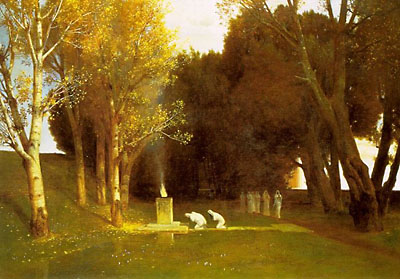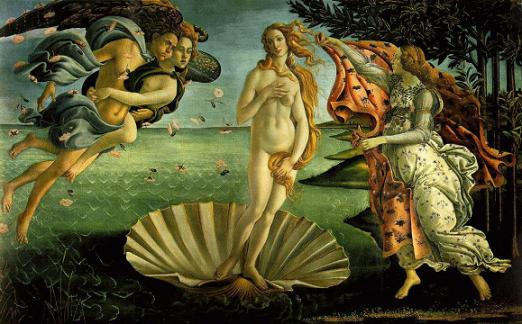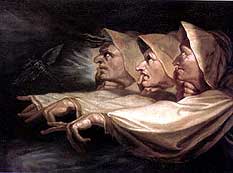|
Disclaimer: This unedited, rough draft material is a year-long project in response to our 2004 theme: pilgrimage. It is meant to be a dialogue between myself and my fellow Mammoths and any of you who happen along. It is intentionally not polished, nor is it finished. Charlie Buchman Ellis -------------------------------------------------------------------------------- Kate got up, fed the dogs, and came back as I got out of bed. She hugged me, said, ďHappy Birthday.Ē I smiled, wiped the sleep out of my newly pierced eyes, grabbed my morning medications, felt the knees pop, and I knew I was 57. E-mail messages from Singapore and Bangkok, send off readings and hymn selections for the service next week at Groveland UUósomething I forgot to do on Friday eveningóget dressed in wool pants, turtle neck, cashmere sweater because Iím heading out to the Jungian Seminar and wonít return until after my birthday dinner at LeVain. Drive into St. Paul, to the Macalester Campus, but first a stop at the bakery on Snelling. ďThese red heart sugar cookies all you have for Valentines?Ē ďYep,Ē said the tired looking woman behind the counter. ďOK, Iíll take 18.Ē The morning class with Liz Burr finds us deep in the Orphic mysteries. It is impossible not to see the astounding roots of Christian perspectives on the soul, heaven/hell, atonement, a suffering messiah. The parallels with the Reformation jump off the page, too. Orphism was a reform movement within the Dionsysiac cults, and a reform movement which facilitated Greek attention to the individual, eliminated the priesthood and the religious institution itself in favor of loose gatherings of believers. There was also a scripture which, because it could be read by literate believers, further reinforced the individual. And Iím just learning about this at 57? Surely this came up somewhere else? This stuff turns me on, I find the Greeks and the Romans fascinating. I might take a classics degree, I like it so much. It seems important, and I expect it does for the same reason it did to professors of classics in English public schools and in US universities in the 19th century. The language, the ideas, the daring, the depth, the radical originality, yet, too, the passion and the ecstasy, the irrational reach beyond. I eat my red heart sugar cookie, drink coffee, and search for connections. This is a place where I feel alive. Later, at lunch, I learn some of my fellow seminar participants are unhappy. ďWhat does this have to do with analysis?Ē As Americans, weíre ok with the esoteric, the learned...for a little while, then. Well. We want to get down to business. Get on with it. Figure out the practical use of this. And if there is no apparent practical utility? Thatís obvious isnít it? The afternoon satisfies my classmates. It is John Desteian, my analyst, in his second four hour segment focused on dreams. Today we actually analyze dreams. Now, this is practical. I find it interesting. Trying to tease out the hidden meaning, the wish fulfillment, or the work yet to be done, and all of it deep within the inner world. The Self working so hard, trying to nudge the ego into a broader embrace of its, well, Self, and often having to settle for repression, or splitting off, or selective amnesia. In one dream a 60 year old man hoses down his house, but the water pressure is low. A woman, a young woman, a helper or his wife, helps him and the water pressure gets better. Hmmm...? Guess where Freud would stop? We work with this dream and the 35 year-old vagrant, a vital young man the dreamer flushes out from under the barn with his higher water pressure hose. I learn to see this as, possibly, an indication of where the dreamerís psychological work upcoming may lie. He may need to investigate his shadow (kept under the barn, but who might be flushed out). I pay attention, but Iíve missed my nap and my eyes begin to feel not only pierced, but dry and staring. Held open by will. My neighbor on my left, a woman with a Ph.D. in the chemistry of human genetics and engaged right now in the last year of a second Ph.D. program in psychology whispers in my left ear. Which is deaf. Oh. I still canít hear, but I nod, smile. Hope Iíve given a close to appropriate response. (I stopped here last night, turned off AccuRadioís All That Jazz channel. Went to bed.)
E-Mail to my brother on 2/14 Mark, At some point past fifty the years take on a surreal quality. That is, they keep adding up, your body changes so you know you're aging, but your mental perception of yourself only racks up the increased learning and experience, and when possible, wisdom. Thus, the further I move from fifty and my eyes get pierced to handle narrow-angle glaucoma (you should be checked for this by the way--Dad had it and I do.), my knees hurt going up stairs, and my hair grays and my beard has turned silver, I see in the mirror this older guy. When I pick up a book to read, or go to a museum, or watch a movie, talk to Joseph, or converse with my friends though, I experience an agile, learned mind filled with metaphor, knowledge, ideas, and a heart with compassion borne of many contradictory moments in my own life. So, how can this be anything but good? A puzzle, not solved in American society, nor, perhaps solvable. The Chinese and the Japanese seem to have a better handle on this phenomenon than we do. I want to take the train from Singapore to Bangkok, I think, then from Bangkok to Mandalay. Is it your impression that might be dangerous? Are the trains ridable? Are there trains on those routes? The other option would be Singapore to Mandalay/Bagan, then to Bangkok, would that make any more sense? I'm excited about seeing your part of the world. How can you afford to travel so much on so little salary? Love, Charlie Dreams have become more clear to me, what they are and why theyíre worth paying attention to and why itís difficult to do so. Prevailing theory among depth psychologists is this: the conscious mind, usually the ego, confronts something it wants (wishes for), but feels reticent, ashamed, fearful. Tuck it into the convenient receptacle nearby, the shadow probably, but possibly deep into the unconscious, beyond the reach even of the shadow. While awake we have enough psychic energy (libido) to keep the ornery thing where it belongs, but as we fall asleep the reigns slip a bit, the horse (our awareness) wanders off the path a bit, and grazes in strange pastures. Ooooh. Strange images. Familiar scenes in unfamiliar guises. Hoses and outsides of houses, young women and vital younger men. You know the drill. But what are these odd bits? A lump of gravy perhaps, as Scrooge thought? Nope, this is our Self, trying, in our psychic economy, to do wish granting, or, at least, from a Jungian perspective, apparent wish granting. But the wishes the psyche trys to grant are those very ones weíve tucked away. They still have energy, they want back into awareness, but our repressive measures, when awake, are strong enough to keep them back. After sleep, they can, to a certain extent slip past the shadow line and into dream awareness. They are, however, still shameful, or stimulants for fear, or just awkward for the ego. So, in order to process them, to allow them a chance at integration, say, they come out in disguise. Why in disguise? If we considered, in a delicate state like sleep, matters that disturbed us, we would wake up. As we do, occasionally, when the dream matter rattles us, anyway. So, the dreamer clothes the matter in symbol, i.e. the hose, the young woman, the outside of the house. Now, with care and attention to the dreamer, and a trained analyst, the dreamerís own psychology, including those things it considers important to hide, becomes apparent if they stick with the dreams. The careful reader would have noted I said, apparent wish granting from the Jungian perspective. The Freudian perspective is that the sole function of the dream is to satisfy the wish. Thus, a retired man, with low water pressure, literally dreams of a life with a better hose and better water pressure. His dreams introduces a young woman who helps him with a better hose, and voila, out of the barn comes a virile young man. Wish granted. Genie back in the bottle. The Jungian perspective, however, goes on from here. Jungian agree with Freudians that the primary function of the dream is wish-fulfillment, but they differ, a lot, on the psychic significance of the wish-fulfillment. The Freudian sees the dream as a closed system: a repressed wish surfaces in a less protected psychic state, the psyche provides the necessary accessories for fulfilling the wish, and that aspect of psychic life has closure. The Jungian sees the same process, often might even agree on the subjective content of the dream, as well as its objective content, however; the Jungian understands the Self as a participant in the dream process. The Self, through the presenting of the dream material to the dreamer, and through the content of the wish fulfillment has not closed the loop, rather, the Self has now signaled to the dreamer rather, ďThis is where we begin.Ē In the dream of the retired man and the hose, it might imply that his work will begin either in events 35 years before, or when he was 35 years of age. It for certain implies that his work is about anima (the animating archetype), the young woman with the better hose, and not about granting his desire for increased libido, or, at least not only about that. So, dreams are important because they deal with aspects of our life which we are reluctant to address, or simply canít address in waking life, at least not right now, but they are difficult to deal with for the same reason. Once we repress something, we try to keep it down, so we forget our dreams, or ignore them, or interpret them in a casual manner.
571 In Woolly years, that is, if you put my 57 with Frankís 71 (Feb. 23rd), as a birthday cake for us both did at Scott Simpson's on our third Monday meeting. Fun. Yin and Scottís house has the air of a Chinese museum coupled with a gracious suburban home. And all those candles. Iíd like to supply the Simpsonís with candles. In the living room fireplace sit at least 15 white pillar candles, some on the hearth, some on cast iron stands, all lit and glowing. They set off orchids and Chinese antiques. When I came in tonight (Monday, February 16, 2004) Yin and Moon, or Bak-Bak (Great-grandmother on the wifeís side), were at the stove cooking. Their food is always unique, unexpected. Tonight itís shrimp, chorizo, and salt and pepper shrimp with sauce, a wonderful salad with a piece of flat bread placed vertically on the plate, and the turtle-sundae birthday cake with 571 candles. Frank and I blew them out together. We got our wish. (but I canít tell what it is.) Frank, the inveterate seeker, has brought me the first book on Falun Gong. He and Mary have begun taking classes. Iím most directly interested in its connection to Taoism which remains a central research interest of mine right now. Frank sees a connections between the movements associated with Falun Gong and the tensegrity exercises Carlos Castaneda taught. Each time he talks about these I recall our first cruise, one through the Panama Canal. On the first morning I got up early and wandered the ship when no one else was up. Except thirty older Chinese men and women on the topmost deck, all practicing tai chai. I admired the fluidity and grace of their movements at an age many Americans write off as arthritic and hopeless. I saw the same phenomenon, only with a wider spread in ages, when Kate and I visited Beijing. In small parks, all over the city, in spite of the winter weather, Beijingers in down jackets practiced this ancient art. We Westerners have very few things which reach back as far in time, and the few we do have tend to be religiousóno real surprise thereóthe rosary, the liturgy of the hours, perhaps for some, study of classical literature and appreciation of art, music. Even if you reach back through Rome to Greece, we have not got the age; only India has a culture which has remained intact and coherent over as long a period as China. Does this make the Chinese way superior? No, I donít think so, nor, does it make inferior. It makes it different, richer in nuance and resonance, yet, perhaps more resistant to change, and change is the one thing which will not go away and the velocity of which has increased almost to the point of recklessness. As we check-in (a group process concept from the sixties so firmly rooted now, it seems usual), we eat and listen. Mark has had a wisdom tooth removed; Stefan is alive and considering the life-threatening bets we make each day in our cars; Frankís painting at the American Indian Service in spite of himself and wondering, ďDid anybody other than Puccini write opera?Ē; Scott speaks of the necessary balance many of us need to find with medication (Me, too) and the addictive high of the manic episode; Tom shakes his head, amused at the way money keeps throwing itself at his feet (I suspect hard work and intelligence has something to do with it.); Charlie Haisletís life has new apartment, new practice hours, new partners, new practice locationóchanges, and heís decided on a poem a week as a pilgrimage; Warren and Cheryl have decided to give each other the same kind of time we Woollies give each other: a Monday night at a restaurant, then, a Monday at home dealing with topics of interest to the two of them; Paulís dipping a toe in the water, getting back out there with some consulting work; and Iím feeling good, medicated and productive. On medication I confess to a puzzle, an epistemological conundrum. I feel better, that is, less edgy, perhaps less fearful, yet, I donít know why. Charlie H. bristles at the contention that we donít know much about neurotransmitters, yet the knowledge Iíve encountered doesnít explain whatís happened to me since I started on Zoloft. 18 years of analysis and I know myself pretty damn well, thank you, but I donít get the effect Zoloft has. In fact, I find it hard to identify precisely, yet I can tell itís on board. It has interfered, to some extent, with the flow of internal images during meditation and I donít like that, though I feel Iím navigating past it these days. Still, how can a pill give me something Iíve sought at the very throne of God? That is, inner peace. And, puzzle 2, how can I separate out the effect of the drug from the effect of my ongoing spiritual practice and analysis? Hmmm. In the last hour Scott tries to teach about local currencies and introduces the Woolly dollar, a variation on the time-dollar concept www.timedollar.org The hour is late and the idea a little too far from current experience, yet... The hope of different ways of handling our common life seems worth exploring. I hope Scott doesnít leave the idea here, but chooses to explore what the concept might mean in an upper-middle class context where daily needs are not so pressing, but other needs might be. At home the dogs need to go out, I forgot the garbage so that has to get out to the street. Kateís not home. I wonder where she is. Has something happened and sheís had to admit a patient to the hospital? It seems the last patient is always the most complicated, requires lab work, or something that requires extra time. I wonder if God finds the same thing? The last few candidates for heaven each day seem to require extra scrutiny or redemption or more forgiveness than seems available at the moment? Who knows the exact burdens of divinity? My guess is the compensation rarely equals the workload. Now, thereís One who could use time-dollars.
I want to start with this diary entry collecting sacred sites in Minnesota and nearby states/provinces. This pipe bowl comes from rock at the Pipestone National Monument. I have not been to this site, but it shows up on Martin Grayís pilgrimage website and when I saw it there, I thought, well, of course. It deserves a spot right next to the other one he mentions, the Jeffers Petroglyphs, and the Witch Tree. If you have a site, let me know. By the end of the year I hope to have as comprehensive a list as possible. The night has fallen heavy on my eyes, the jazz from Moscow on 10th button radio has grown grating to my ears. I need sleep and dreams.
This is a Symbolist work by Bocklin called Sacred Woods. The Symbolists and the Pre-Raphaelites have a special fascination for me, and, I suspect, they have a good deal to do with my pilgrimage. My aesthetic has, like Zoloft, also puzzled me for some time. I have, both by training and years of personal discipline, developed my own canons of appreciation. In spite of them, or because of them, I have definite zones of appreciation. I donít know what else to call them. The Symbolist and Pre-Raphaelite painters provide a good jumping off point. Sacred Woods speaks to me. Without intruding too much on my rational mind, it evokes spiritual yearning, a desire to bow down and worship, to see the divinity of fire, of the setting sun, of sacred paths in mysterious forests. On the other hand, is Sacred Woods a painting to compete with this one?
I donít think so; Botticelli has color, design, subject matter, grace, painterly skill over Bocklin. Letís make the distinction, the zone even more disjunctive:
Iím still there, drawn in, transported. I could continue this exercise with folk religious art, or Josephís elementary school pastels.
Iím picking up this thread the next night, and I want to close it off for now. My point is that everything from an Odegard poster for the Firemanís Ball to the purba and the Brandeburg photograph of three ravens, heads together on the snow call to me. High, low, painterly, graphic design, ritual tool, maybe the common thread lies in the melding of hand and imagination, eye and a certain way of seeing...anything that causes me to look once, then again, and to see something new, or to see a familiar thing anew. Art makes my heart sing. And I love the objects and their creators for that. A Gathering of Clergy Talk about strange paths, the ministry has a weirdness, and I suppose, in a way thatís good. From the Proto-Indo-European *wer, meaning "to turn." From this same root, we also get the English words: -ward (toward, inward), worth (from the Old German *werthaz, meaning "opposite," thus "equivalent"), pervert, extro/introvert, divert, controversy, invert, verse, versatile, revert, tergiversation, malversation, anniversary, vertex, vertigo, vertebra; wreath, wrath; worry (from the Old English wyrgan, to strangle), wrong (from the Old Scandanavian *vrang, for "crooked"); verge, converge, diverge; wry, wriggle, wrist, wrestle; warp; rhapsody; worm, vermin; the Latin prefix "re-".
weird - O.E. wyrd "fate" (n.), from P.Gmc. *wurdis. The modern sense developed from M.E. use of weird sisters for the three fates or Norns (in Gmc. mythology), the goddesses who controlled human destiny. They were usually portrayed as odd or frightening in appearance, as in "Macbeth," which led to the adj. meaning "odd-looking, uncanny," first recorded 1815. Weirdo is from 1955.
Weird Weird is an example of a word whose most common modern meaning is quite different from its original English meaning. It is an old word, found in Beowulf (spelled wyrd), "Gśū a wyrd swa hio scel" and "Hie wyrd forsweop on Grendles gryre," as well as other Old English manuscripts. In its original sense it was a noun meaning fate or destiny. Also, quite early on it was used to mean someone who controlled another's fate, like a witch. The use of weird as a synonym for witch was quite common in Scotland. The OED2 says that it was less common in Middle English, being found chiefly in northern texts, although it does appear in Chaucer. The use of weird as an adjective dates to 1400 and is found in the manuscript (Scottish) Trojan War: "Vperis said sche was, I trow, A werde-sister, I wait neuir how." The use of weird sister is found in several manuscripts leading up to its most famous appearance in Shakespeare's Macbeth. Until its appearance in the Scottish Play, the adjectival use was restricted to the phrase weird sister. Only after Shakespeare used the term, did its use expand to other contexts. The modern sense meaning strange or uncanny dates only to the early nineteenth century. Webster's 1828 dictionary only records it as an adjective, "no longer in use," meaning skilled in witchcraft. Ayto claims that this modern sense derives from "semantic liberties" taken with Shakespeare's usage. Do you remember the movie, ďThe Viking?Ē Kirk Douglas and Tony Curtis. I saw the movie in 1958, which would make me 11 at the time. I found the book and read it. A little racy for an 11-year old Hoosier boy, but what the hell. Anyhow, wyrd kept popping up in the text, and I think it was then when I realized there were alien world views, the perspectives of others, people not Americans, people not of our time. Oh, sure, Iíd read about them before, but it was this word, wyrd, its exotic sound and spelling, yet its near-familiarity, as if spoken by an unsuspected branch of the family, far distant, yet related somehow. Added to its strangeness as an object, which thrilled me (and, by the way, still does), and embedding it forever in my own world-view, was its meaning: fate. What was my wyrd? Might I end my life with a Viking burial at sea, flaming arrows arcing through a night sky filled with stars? No, probably not. I think I knew even then, though only dimly, my fate lay in my response to the word itself. As I would find again only 2 years later when I discovered Richard Wagnerís Ring Cycle, the dragon ship which would carry me to distant lands was scholarship, not pillaging and berserking. OK, maybe a little berserking.
Iím still on that dragon ship, Iíve sailed in and out of intellectual and aesthetic and religious ports; I still read, search for the frisson I felt early on when I found my wyrd among the words from my own Teutonic heritage.
I didnít finish this thought, I got off on the wyrd weird word and forgot to mention I attended a meeting of UU community clergy last night. Community clergy have ordination, but do not work in parishes. One woman, 78, is a historian, three are hospital-based chaplains, one runs the Pagan Institute, another is a prison chaplain, and the only other guy there, Highpockets, as he calls himself works with heart transplant patients. My entire ministry has woven itself in and out of marginal communities, in the culture at large and within ecclesia. I miss the collegiality, the mutual recognition of others who share the same sense of calling, vocation, yet I often donít know I miss it until I gather with other clergy as we did at Anne Galloway-Eggeís. In this sense I miss being seenóquite literallyóas clergy. Among these folks, marginal religious leaders in a marginal religious movement, I feel right at home. I have experience, wisdom gained from education and praxis, something concrete to share to others on the wide weird road of ministry. Though I disagree with the Catholics on many, many things there are also areas where I embrace their perceptions wholeheartedly. One of them is on ordination as an indelible mark. No matter how far away from the day-to-day life of a clergy I still feel a responsibility for religious leadership, even if exercised now from a keyboard and cable modem most of the time. No, not leadership in the sense of hierarchyóthe Catholics and I are miles apart on that oneóbut in the sense of honoring each persons sacred journey, and doing my part to provide resources and hospitality to these travelers. I spent many years focused on nurturing the institutional church: congregations, clergy, mission programs, and many more before that focused on supporting people in struggle, now I find myself more attentive to the religious journey itself. I have little interest in the institution anymore; I have a little more for political work, but not near what I used to have. Tonight in my Southeast Asian art class at the Minneapolis Institute of Arts I learned one version of the Hindu sacred journey. Among Hinduís, I was told, the path takes you away from statues to recognizing the Brahman with no aids. Once there you may still see Shiva Nataraja, Lord of the Dance, but you will know that Shiva dances his destructive/creative dance within the great fiery ring of the cosmos, but you will know its true location; it lies within your self. ďThe Kingdom (Empire) of God is within you.Ē ďI can see for miles and miles and miles...Ē Blessed be.
Last entry for this week. Some weeks I sort of chug along, nothing much happens and groceries, snow, e-mail, visits with family, feeding the dogs seem to fill the time. Then, as if a literal shift into a lower gear occurs, I bite down more on the road. This week has taken a lower gear. Last Saturday was my birthday, Sunday was Chinese New Yearís at the Chinese Seafood Palace. Scott had the Woollys on Monday night, Wednesday Kate and I bought a universal gym, the Vectra 1850 with money left to me by my father, and hired Kari Larson for 12 sessions of personal training. Wednesday evening was the gathering of UU community clergy, last night I focused on Hindu art and Islamic culture at the Institute, and this morning, I had my first drawing class...ever. Boy, drawing will prove a challenge. I expected it too, so no surprise, but the intensity and the level of difficulty...hmmm. A lot like writing. A whole lot. I had several reasons for wanting to take this class: a desire of longstanding to add drawing (not photography) to my journals, especially when I travel. Iíve always admired the Victorian diarists who drew Mayan ruins, South American volcanoes, and the work of Bodmer in the early 19th century of the interior of the US, Piranesi. Below is a piece by Frederick Catherwood. I have no illusions about jumping to this skill level before I turn 70 or so, still I like the intentionality drawing brings to travel observations. Also, Iíve had an interesting synergy all year between the Jungian seminar on the one hand and the work I do at the Art Institute. Sheila Asatoís class, the drawing class, is, in fact, sponsored by the Minnesota Jung Association. Stefan Helgeson, who has a BFA, is in the class, too. His skill is wonderful. Itís good to see him work in this way.
Jung works with the primary language of the mind, images, so there is a great deal of congruence, according to Sheila, between in-sight and outer sight. Mostly I wanted to gain a language, both visual and verbal, for the connections between the Jung seminar and the study of art. This will be rich since I have not used this aspect of mySelf much, so it represents a Way Iíve not traveled. I plan to use drawing to document my travels in Southeast Asia, and on my pilgrimage throughout the year. Eventually, Iíll begin to add them to this diary. Enough for this week.
Charlie Buchman Ellis Top < Previous Next > |







